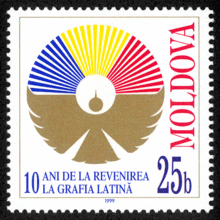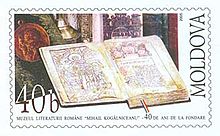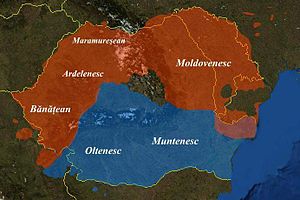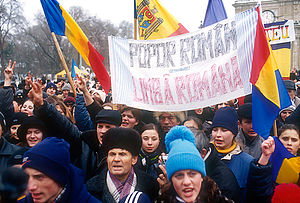- Moldovan language
-
Eastern Romance languages Vulgar Latin language
Substratum
Thraco-Roman cultureMoldovan (also Moldavian; limba moldovenească, лимба молдовеняскэ) is one of the names of the Romanian language as spoken in the Republic of Moldova, where it is official.[1][2] The spoken language of Moldova is closer to the dialects of Romanian spoken in northeastern Romania, and the two countries share the same literary standard.[3] Written in Cyrillic,[4] Moldovan is also the name of one of three official languages of the breakaway Moldovan territory of Transnistria.[5]
The Constitution of Moldova (Title I, Article 13) states that the Moldovan language is the official language of the country. In the Declaration of Independence of Moldova, the state language is called Romanian.[6] The 1989 Language Law that proclaimed it the state language of Moldova, speaks in the preamble of a "Moldovan-Romanian linguistic identity". After political debate over the issue became inflamed again in the early 2000s, a group of Romanian linguists adopted a resolution stating that promotion of the notion of Moldovan language is an anti-scientific campaign.[7]
The term Moldavian is also used to refer collectively to the north-eastern varieties of spoken Romanian, spread approximately within the territory of the former Principality of Moldavia (now split between Moldova and Romania). The Moldavian variety is considered one of the five major spoken varieties of Romanian, all five being written identically. There is no particular linguistic break at the Prut River, the border between Romania and Moldova.
In Moldova's schools, the discipline about the state language is called "Romanian language", though former Moldovan president Vladimir Voronin asked for it to be changed into "Moldovan language".[8]
The standard alphabet is Latin (currently official in the Republic of Moldova). Before 1989, two versions of Cyrillic had been used: the Moldovan Cyrillic alphabet in 1924–1932 and 1938–89, and the historical Romanian Cyrillic alphabet until 1918. As of 2010[update], the former remains in use only in Transnistria.
Contents
History and politics
The history of the Moldovan language refers to the historical evolution of the glottonym Moldavian/Moldovan in Moldova and beyond, which is closely tied to the region's political status, with long periods of rule by Russia and the Soviet Union influencing the language's name and (when Cyrillic script was in use) orthography. From a linguistic perspective, this term is an alternative name for the varieties of the Romanian language spoken in the Republic of Moldova (see History of the Romanian language).
Before 1918 and also after the union of Bessarabia with Romania, it was not obvious nor universally accepted that Moldovans and the Romanians formed a single ethnic group.[9] Missing out all the important moments in the creation of a pan-Romanian national consciousness, the Moldovan peasants referred to themselves and their language as "Moldovan" also in the period between the wars. This caused reactions from pan-Romanian nationalists.[10] The concept of the distinction of Moldovan from Romanian was explicitly stated only in the early 20th century, and accompanied the raising of national awareness among Moldovans, and the Soviet placing heavy emphasis on Moldavians vs Romanians as a reaction to this awareness.[11]
Major recent developments include the passing to a Latin script from Cyrillic in 1989 and several changes in the statutory name of the language used in Moldova. At one point of particular confusion about identity in the 1990s, all references to geography in the name of the language were dropped, and it was officially known simply as limba de stat - "the state language".
Moldovan was assigned the code
moin ISO 639-1 and codemolin ISO 639-2 and ISO 639-3[12] but these have been deprecated in November 2008, leavingroandron(639-2/T) andrum(639-2/B) the current language identifiers to be used for the variant of the Romanian language also known as Moldavian and Moldovan in English, the ISO 639-2 Registration Authority said in the motivation of the decision.[13][14]Reversion to Latin script, and beyond
In 1989, the contemporary Romanian version of the Latin alphabet was made the official script of the Moldavian SSR.
In the Declaration of Independence[15] of Moldova (27 August 1991), the official language was named "Romanian", but the 1994 constitution declared Moldovan the state language.
When in 1992 the Romanian Academy changed the official orthography of Romanian language, the Institute of Linguistics at the Academy of Sciences of Moldova did not make the changes, and the official orthography continued as before until 2001 when the changes introduced by the Romanian Academy were adopted by the Moldovan Academy.
A 1996 attempt by Moldovan president Mircea Snegur to change the official language to "Romanian" was dismissed by the Moldovan Parliament as promoting "Romanian expansionism".
In 2003, a Moldovan-Romanian dictionary (Dicţionar Moldovenesc-Românesc (2003), by Vasile Stati) was published. The linguists of the Romanian Academy in Romania declared that all the Moldovan words are also Romanian words, although some of its contents are disputed as being Russian loanwords. In Moldova, the head of the Academy of Sciences' Institute of Linguistics, Ion Bărbuţă, described the dictionary as "an absurdity, serving political purposes". Stati, however, accused both of promoting "Romanian colonialism".
In the 2004 census, 16.5% (558,508) out of the 3,383,332 people living in Moldova declared Romanian as their native language, whereas 60% declared Moldovan. While 40% of all urban Romanian/Moldovan speakers declared Romanian as their native language, in the countryside barely a seventh of the Romanian/Moldovan speakers indicated Romanian as their native language.[16]
In October 2009, Vlad Filat, the new Prime Minister of Moldova, announced that he intends to propose changes in the Constitution regarding the name of the language, replacing "Moldovan" with "Romanian".[17]
Linguistic aspects
There are, however, regional differences in the colloquial spoken language. The Moldovan dialect/variety is common in the Republic of Moldova, as well as in Chernivtsi Oblast and Budjak region of Ukraine, and in eight counties of Romania, territories that once made up the medieval Principality of Moldavia. The difference between the language spoken in Chişinău and Iaşi and the language spoken for example in Bucharest could be roughly compared to that between Standard British and Scottish or American English.[citation needed] Others have argued that these differences might be found within any linguistic territory.[citation needed]
- The Romanian vocabulary in parts of Moldavia, Bessarabia and Transnistria. Researches made by Gustav Weigand:
Controversy
Main article: Controversy over national identity in MoldovaSee also: MoldovenismThe matter of whether or not "Moldovan" is a separate language is a contested political issue within and beyond the Republic of Moldova.
The 1989 Language Law of the Moldavian SSR, which is still in force in Moldova (according to the Constitution,[18]) asserts the existence of a "linguistic Moldo-Romanian identity".[19] Article 13 of the Moldovan Constitution, names it "the national language of the country" (the original uses the term limba de stat, which literally means the language of the state, or official language, thus avoiding the term national, whose sense is that of ethnicity).
In the breakaway region of Transnistria, it is co-official with Ukrainian and Russian.
Despite the official nomenclature, standard "Moldovan" is widely considered to be identical to the standard Romanian.[20] Writing about "essential differences", Vasile Stati, supporter of Moldovenism, is obliged to concentrate almost exclusively on lexical rather than grammatical differences. Whatever language distinctions may once have existed, these have been decreasing rather than increasing: "... in the main, Moldovan in its standard form was more Romanian by the 1980s than at any point in its history".[21]
In 2002, the Moldovan Minister of Justice, Ion Morei, said that Romanian and "Moldovan" are the same language and that the Constitution of Moldova should be amended, not necessarily by changing the word Moldovan into Romanian, but by adding that "Romanian and Moldovan are the same language".[22] Education Minister Valentin Beniuc said, "I have stated more than once that the notion of a Moldovan language and a Romanian language reflects the same linguistic phenomenon in essence."[23] The President of Moldova, Vladimir Voronin, acknowledged that the two languages are identical, but said that Moldovans should have the right to call their language "Moldovan".[24]
In the 2004 census, out of the 3,383,332 people living in Moldova, 60% chose Moldovan as their native language, whereas only 16.5% chose Romanian. While 37% of all urban Romanian/Moldovan speakers chose Romanian as their native language, in the countryside barely one in seven Romanian/Moldovan speakers indicated Romanian as his native language.[16] Independent studies found a Moldovan linguistic identity asserted in particular by the rural population and post-Soviet political class.[25] In a survey conducted in four villages near the border with Romania, when asked about their native language the interviewees stated: Moldovan 53%, Romanian 44%, Russian 3%.[26]
When reporting on EU Council deliberations regarding an agreement between the European Community and Moldova, the Romanian rapporteur Jean Marin Marinescu included a recommendation not to make references to the Moldovan language.[27] This led to speculation in the Romanian press that supposedly the EU banned the usage of the term "Moldovan language."[28] However, the European Commissioner for External Relations and European Neighbourhood Policy, Benita Ferrero-Waldner, denied these allegations and stated that the Moldovan language is referred to in the 1998 Cooperation Agreement between the EU and Moldova and hence it is considered a part of the acquis, binding to all member states.[29]
Orthography
See also: Romanian alphabet and Moldovan Cyrillic alphabetThe language was generally written in a Romanian Cyrillic alphabet (based on the Old Church Slavonic alphabet) before the 19th century. From then and until World War I, both Old Cyrillic and Latin were used, at which point the Old Cyrillic alphabet fell out of use. In the interwar period, Soviet authorities in Transnistria (Moldavian Autonomous Soviet Socialist Republic) alternately used Latin or Cyrillic for writing the language, mirroring the political goals of the moment. Between 1940 and 1989, i.e. during the Soviet rule, the new Moldovan Cyrillic alphabet replaced Latin as the official alphabet in Moldova (then Moldavian SSR).[30] In 1989, Latin script was adopted in Moldova again, along with the orthographic rules used in Romania at the time, whilst officially Transnistria still uses the Cyrillic alphabet.[5]
See also
- Moldovan
- Moldovenism
- Varieties of the Romanian language
- Thraco-Roman
- Eastern Romance substratum
- Romanian language
- Origin of the Romanians
- Romance languages
- Legacy of the Roman Empire
- The Balkan linguistic union
Notes
- ^ (Romanian) Article 13, line 1 - of Constitution of Republic of Moldova
- ^ Kogan Page 2004, p. 242
A Field Guide to the Main Languages of Europe - Spot that language and how to tell them apart, on the website of the European Commission - ^ James Minahan, Miniature empires: a historical dictionary of the newly independent states, Greenwood Publishing Group, 1989, pp. 276
"The Library of Congress -- Moldova, Country Study". http://lcweb2.loc.gov/frd/cs/mdtoc.html#md0027. Retrieved 2008-06-03.
"Encyclopedia Britannica (via indiana.edu)". http://www.indiana.edu/~libslav/slavcatman/langcode.html. Retrieved 2008-06-03.
"NYU LAW, A country-by-country update on constitutional politics in Eastern Europe and the ex-USSR". http://www.law.nyu.edu/eecr/vol11num1_2/constitutionwatch/moldova.html. Retrieved 2008-06-03.
"The Sovietization of Moldova". http://www.jmu.edu/orgs/romanian/moldova1.htm. Retrieved 2008-06-03.
"Ethnologue.com, data on Moldova". http://www.ethnologue.com/show_country.asp?name=Moldova. Retrieved 2008-06-03.
"Disillusionment with Democracy: Notes from the Field in Moldova" (PDF). http://www.ksg.harvard.edu/kokkalis/GSW5/anderson.pdf. Retrieved 2008-06-03.
"BBC on the Moldovan language". http://www.bbc.co.uk/languages/european_languages/languages/moldovan.shtml.
(Russian)Л. И. Лухт, Б. П. Нарумов. Румынский язык // Языки мира. Романские языки. М., Academia, Институт языкознания РАН, 2001 - ^ Derived from the Russian alphabet and developed in the Soviet Union since the 1930s, the modern Moldovan Cyrillic alphabet is different from the Romanian Cyrillic alphabet used in the Principality of Moldavia and by the other Moldovan/Wallachian language-speakers before 1857: Denis Deletant, Slavonic letters in Moldova, Wallachia & Transylvania from the tenth to the seventeenth centuries, Ed. Enciclopedicӑ, Bucharest 1991
- ^ a b "Article 12 of the Constitution of Pridnestrovskaia Moldavskaia Respublika". Kspmr.idknet.com. http://www.kspmr.idknet.com/eng/k_I.htm. Retrieved 2011-02-26.
- ^ (Romanian)Declaraţia de independenţa a Republicii Moldova, Moldova Suverană
- ^ (Romanian) "Ziare.ro — Linguists condemn "Moldovan language"". http://www.ziare.ro/articol.php?id=1193864896. Retrieved 2007-11-10.
- ^ "DECA-Press ''Professors from the University of Balti protest against replacing "Romanian language" with "Moldovan language"''". Social.moldova.org. 2007-12-18. http://social.moldova.org/news/professors-from-the-university-of-balti-protest-against-replacing-romanian-language-with-moldovan-language-81780-eng.html. Retrieved 2011-02-26.
- ^ King 2000, p. 57-59.
- ^ King 1999, p. 120.
- ^ Library of the US Congress Country Study, Moldova — Language, Religion and Culture — Language: "Stalin justified the creation of the Moldavian SSR by claiming that a distinct 'Moldavian' language was an indicator that 'Moldavians' were a separate nationality from the Romanians in Romania. In order to give greater credence to this claim, in 1940 Stalin imposed the Cyrillic alphabet on 'Moldavian' to make it look more like Russian and less like Romanian; archaic Romanian words of Slavic origin were imposed on "Moldavian"; Russian loanwords and phrases were added to 'Moldavian'; and a new theory was advanced that "Moldavian" was at least partially Slavic in origin. (Romanian is a Romance language descended from Latin.) In 1949 Moldavian citizens were publicly reprimanded in a journal for daring to express themselves in literary Romanian. The Soviet government continued this type of behavior for decades. Proper names in Moldova were subjected to Russianization as well. Russian endings were added to purely Romanian names, and individuals were referred to in the Russian manner by using a patronymic (based on one's father's first name) as a middle name." [1]
- ^ SIL International: ISO 639 code sets: Documentation for ISO 639 identifier: mol
- ^ "Code Changes: ISO 639-2 Registration Authority". US Library of Congress. http://www.loc.gov/standards/iso639-2/php/code_changes.php. "The identifiers mo and mol are deprecated, leaving ro and ron (639-2/T) and rum (639-2/B) the current language identifiers to be used for the variant of the Romanian language also known as Moldavian and Moldovan in English and moldave in French. The identifiers mo and mol will not be assigned to different items, and recordings using these identifiers will not be invalid"
- ^ "ISO 639 JAC decision re mo/mol". Alvestrand.no. http://www.alvestrand.no/pipermail/ietf-languages/2008-November/008635.html. Retrieved 2011-02-26.
- ^ (Romanian) Declararaţia de Independenţă a Republicii Moldova (Declaration of Independence of the Republic of Moldova)
- ^ a b National Bureau of Statistics of the Republic of Moldova: Census 2004
- ^ Voronin denuntat ca militian la Bruxelles, Ziua, October 1, 2009
- ^ Constitution of the Republic of Moldova, Title 7, Article 7: "The law of 1 September 1989 regarding the usage of languages spoken on the territory of the Republic of Moldova remains valid, excepting the points where it contradicts this constitution."
- ^ (Romanian) Legea cu privire la funcţionarea limbilor vorbite pe teritoriul RSS Moldoveneşti Nr.3465-XI din 01.09.89 Vestile nr.9/217, 1989 (Law regarding the usage of languages spoken on the territory of the Republic of Moldova): "Moldavian SSR supports the desire of the Moldovans that live across the borders of the Republic, and considering the really existing linguistical Moldo-Romanian identity—of the Romanians that live on the territory of the USSR, of doing their studies and satisfying their cultural needs in their maternal language."
- ^ Kogan Page 2004, p 291 ; IHT, 16 June 2000, p. 2 ; Dyer 1999, 2005
- ^ King 2000
- ^ Ion Morei: The Moldovan language is identical to the Romanian language, Moldova Azi, 10 September 2002
- ^ (Romanian) Din nou fără burse, Jurnal de Chişinău, 25 May 2004
- ^ (Romanian) Mediafax interview
- ^ Ciscel 2008, p. 104
- ^ Arambaşa 2008, p. 358,364
- ^ http://www.europarl.europa.eu/sides/getDoc.do?pubRef=-//EP//NONSGML+REPORT+A6-2007-0427+0+DOC+WORD+V0//EN
- ^ (Romanian) "Orban a eliminat “limba moldovenească” de pe site-ul Comisiei Europene"
- ^ Answer given by Mrs Ferrero-Waldner on behalf of the Commission, December 19, 2007
- ^ "Language policy in the Soviet Union" Grenoble 2003, pp 89-93
References
- Dyer, Donald Leroy (1999). The Romanian Dialect of Moldova: A Study in Language and Politics. Lewiston, NY: E. Mellen. ISBN 0-7734-8037-4.
- Dyer, Donald Leroy (1996). Studies in Moldovan : the history, culture, language and contemporary politics of the people of Moldova. New York: Columbia University Press (East European Monographs). ISBN 0-88033-351-0.
- Stati, V. N. (2003). Dicţionar moldovenesc-românesc. Chişinău: Tipografia Centrală (Biblioteca Pro Moldova). ISBN 9975-78-248-5.
- Dumbrava, V. (2004). Sprachkonflikt und Sprachbewusstsein in der Republik Moldova: Eine empirische Studie in gemischtethnischen Familien (Sprache, Mehrsprachigkeit und sozialer Wandel). Bern: Peter Lang. ISBN 3-631-50728-3.
- King, Charles (1999). "The Ambivalence of Authenticity, or How the Moldovan Language Was Made". Slavic Review 58 (1): 117–142.
- King, Charles (2000). The Moldovans: Romania, Russia and the Politics of Culture. Hoover Institution Press. ISBN 0-8179-9792-X. http://books.google.com/?id=ldBFWtuv8DQC&printsec=frontcover.
- Ciscel, Matthew H. (2008). "Uneasy Compromise: Language and Education in Moldova". In Pavlenko, Aneta. Multilingualism in post-Soviet countries. pp. 99–121.
- Arambaşa, Mihaela Narcisa (2008). "Everyday life on the eastern border of the EU – between Romanianism and Moldovanism in the border area of the Republic of Moldova and Romania". South-East Europe Review (3): 355–369.
- Grenoble, Lenore A. (2003). Language Policy in the Soviet Union. Springer. ISBN ISBN 1-4020-1298-5.
- M. Bărbulescu, D. Deletant, K. Hitchins, S. Papacostea, P. Teodor (2004). Istoria României. Corint. ISBN 973-653-514-2.
- Europe Review 2003/2004. Kogan Page. 2004.
- Movileanu, N. (1993). "Din istoria Transnistriei (1924-1940)". Revista de istorie a Moldovei (#2).
- Negru, E. (1999). "Introducerea si interzicerea grafiei latine in R.A.S.S.M". Revista de istorie a Moldovei (#3-4).
- Zabarah, Dareg A. (2010). "The linguistic gordian knot in Moldova: Repeating the Yugoslav Experience?". Srpski Jezik (XV/1-2, p. 187-210).
Further reading
- Ciscel, Matthew H. (2007). The Language of the Moldovans: Romania, Russia, and Identity in an Ex-Soviet Republic. Lanham: Lexington Books. ISBN 0739114433. - About the identity of the contemporary Moldovans in the context of debates about the their language.
External links
- Soviet Union and the creation of Moldovan language
- Translation of Russian loans and irregularities of the spoken language in the Republic of Moldova by Eleonora Rusnac, President, Association of Professional Translators of Moldova.
- Ethnologue report for Moldova
- Academy of Sciences of Moldova
- Conference presentation by Tamara Cărăuş, about identity issues in Moldova (Romanian)
Romance languages Western and Italo-Dalmatian Western Gallo-Italic LigurianOthersGallo-Rhaetian Burgundian · Champenois · Franc-Comtois · French (Standard · African · Canadian · Old French · Middle French · Judaeo-French · French-based creoles) · Gallo · Lorrain · Norman · Picard · Poitevin · Saintongeais · WalloonRhaeto-RomanceOthersOccitano-
RomanceAuvergnat · Gascon (Aranese) · Languedocien · Limousin · Provençal (Niçard · Mentonasc) · Vivaro-Alpine · Old Provençal · Judaeo-ProvençalIbero-Romance Astur-LeonesePortuguese (European · Brazilian · African · Asian & Oceanian) · Galician (Eonavian) · Fala · Judaeo-Portuguese · Portuguese Calão · Portuguese-based creolesAfrican (Equatoguinean) · American · Asian · Peninsular · Old Spanish · Judaeo-Spanish · Spanish Caló · Spanish-based creolesPyreneanItalo-Dalmatian OthersEastern and Sardinian Eastern Moldovan · VlachOthersSardinian —Italics indicate extinct languages; bold indicates languages with more than 5 million speakers; languages between parentheses are varieties of the language on their left.Romanian language (articles) Subdialects Dialects / related languages Linguistics Historic evolution Institutions Other Romanians (origin, Romanianization) • Name • Balkan sprachbund • Romanian Cyrillic alphabet • Moldovan • Vlach
Wikimedia Foundation. 2010.






















